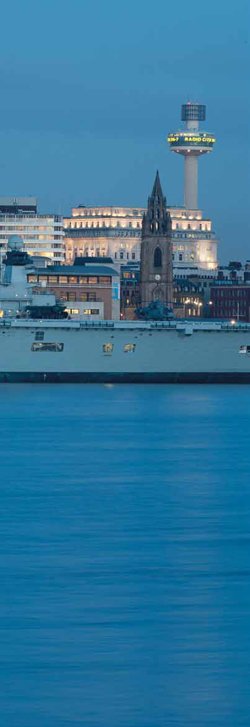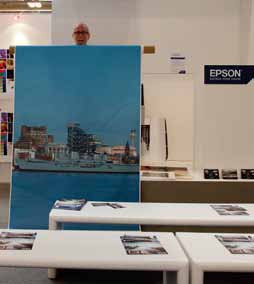articles/Printing/gold-page3
Panning for Gold in the Real World - part 3 of 1 2 3 4 5
by Mike McNamee Published 01/04/2013

A full-size clip from the original pan without any interpolation or up-scaling.
Another thing we have found is that the LCD on the rear of a camera looks very bright against the dark background and it is easy to under-expose - we aim to place the histogram with the bulk of data in the lower 3/4 leaving the street lights and harbour lights to just reach clipping. The final part of the workflow is to correct for vignetting by actually taking RGB readings from the RAW interface, sharpening, making global tweaks to colour balance and exposure, and then finally sending the files to TIFFs using Photoshop's image processor. Hugin requires TIFFs or JPEGs although as you will see in a moment Hugin was abandoned quite quickly!

McNamee is not really tall enough for holding up wallpaper drops, even standing on a stage!
Skies and clouds remain a problem area for stitching images, especially so when no buildings or ground features are present in the images to be stitched. Indeed, Hugin was abandoned because it insisted on placing Beetham Tower upside down in the sky. Photoshop's Align Layers worked on the buildings but failed to stitch the clouds and so we resorted to manual assembly and positioning of the clouds on top of an automatically arranged buildings row. The sea is similarly problematic, the tidal flow ensures that every 4s exposure is radically different to its neighbour and a small amount of motion blur is sometimes used to smear over the defects!
Please Note:
There is more than one page for this Article.
You are currently on page 3
- Panning for Gold in the Real World page 1
- Panning for Gold in the Real World page 2
- Panning for Gold in the Real World page 3
- Panning for Gold in the Real World page 4
- Panning for Gold in the Real World page 5
1st Published 01/04/2013
last update 09/12/2022 14:54:48
More Printing Articles
There are 17 days to get ready for The Society of Photographers Convention and Trade Show at The Novotel London West, Hammersmith ...
which starts on Wednesday 14th January 2026





